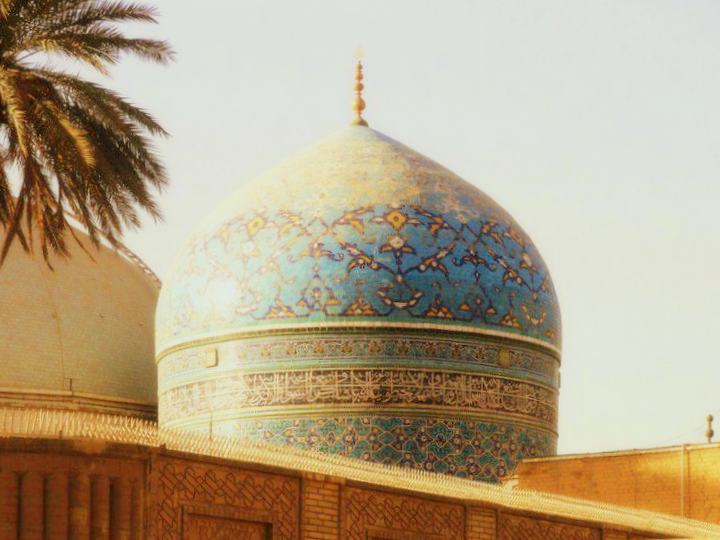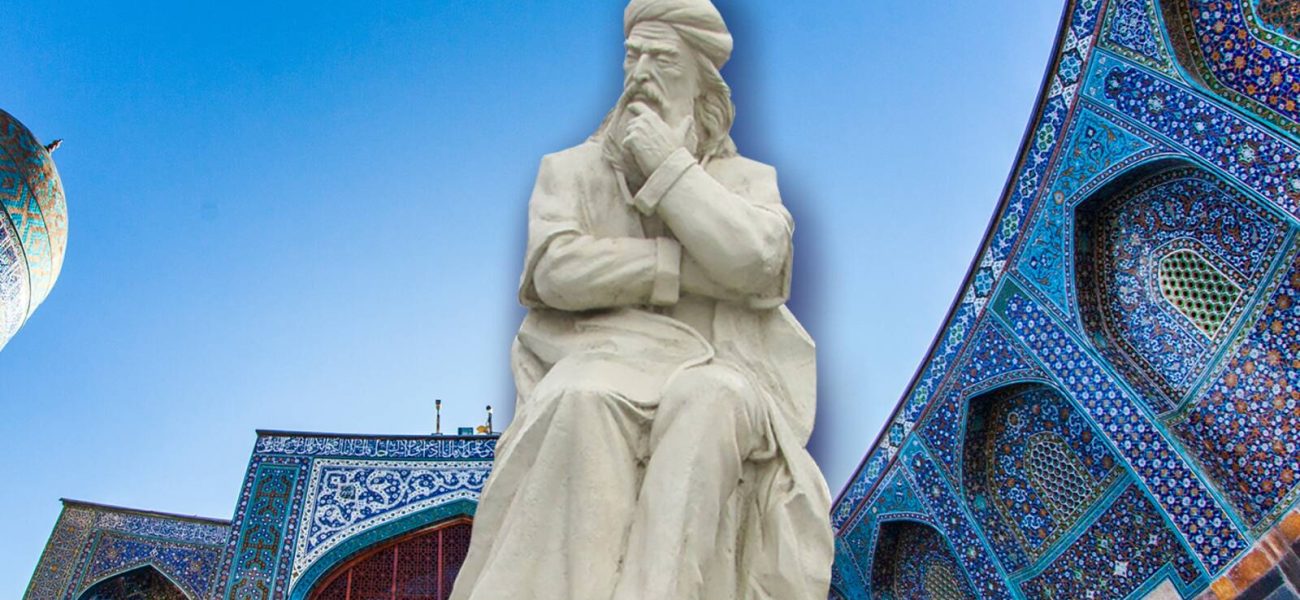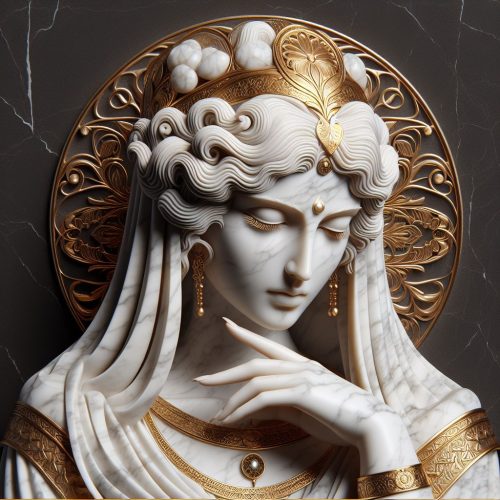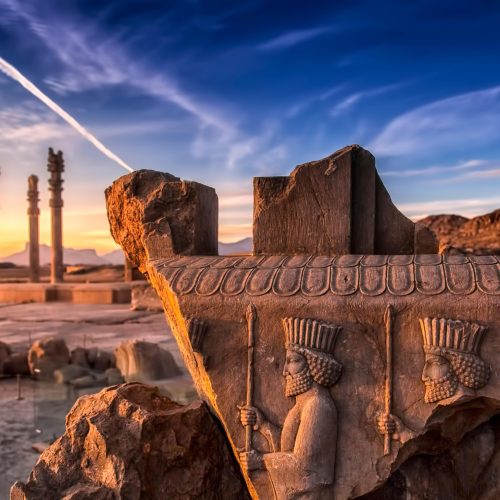Introduction
In the heart of Persia, amidst the blossoming fields and whispering winds, there lived a saint whose spiritual and cultural legacy would illuminate the annals of Iranian history. Safi-ad-Din Ardabili, a name that reverberates with sanctity and poetic grace, was not just a spiritual luminary but also a patron of Persian arts and culture. His life story, woven with divine threads, resonates with the timeless beauty of Persian literature and the profound depths of Sufi mysticism.
Safi-ad-Din Ardabili was born in 1252 CE in the enchanting town of Ardabil, nestled in the verdant embrace of the northwestern region of Persia. Ardabil, a town with ancient roots and a rich cultural tapestry, provided the perfect backdrop for the emergence of such a prodigious soul. His lineage, tracing back to the Prophet Muhammad, endowed him with an inherent spiritual nobility and a sense of purpose that would guide his journey.
Born into the Musha’sha’iyyah family, Safi-ad-Din was the son of Amin al-Din Jibrail, a respected scholar and mystic. From an early age, Safi-ad-Din exhibited an insatiable thirst for knowledge and a profound inclination towards spirituality. His early education was marked by the study of the Quran, Hadith, and Persian poetry, which instilled in him a deep appreciation for the linguistic and cultural heritage of his homeland.
The transformative phase of Safi-ad-Din’s life began with his spiritual quest. At the age of twenty, he embarked on a journey to seek enlightenment and divine wisdom. This quest led him to the revered Sufi master Sheikh Zahed Gilani, a prominent figure in the Sufi order of the time. Under Sheikh Zahed’s guidance, Safi-ad-Din delved deep into the mystical realms of Sufism, embracing the path of spiritual purification and divine love.
Sheikh Zahed recognized the extraordinary potential in his disciple and, upon his own passing, bestowed upon Safi-ad-Din the mantle of leadership. Thus, Safi-ad-Din Ardabili ascended as the Murshid (spiritual guide) of the Safavid order, a branch of the Zahidi Sufi lineage. His role as Murshid was not merely that of a spiritual leader; he became a beacon of light for countless seekers, illuminating their path with wisdom and compassion.
Safi-ad-Din’s teachings were imbued with the essence of divine love and the pursuit of spiritual perfection. His approach to Sufism was characterized by simplicity, sincerity, and an unwavering devotion to God. Central to his teachings was the concept of ‘Ihsan’ – the attainment of excellence in worship and conduct, striving to serve God as though one sees Him.
The daily practices of the Safavid order under Safi-ad-Din’s guidance included rigorous spiritual exercises, communal prayers, and the recitation of mystical poetry. His followers, drawn from diverse backgrounds, found solace and inspiration in his teachings. The khanqah (Sufi lodge) of Ardabil became a sanctuary for those seeking spiritual refuge, a place where hearts were purified, and souls were nurtured.
Safi-ad-Din Ardabili was not only a spiritual guide but also a gifted poet whose verses continue to resonate through the corridors of Persian literature. His poetry, written in both Persian and Azeri, is a testament to his profound spiritual experiences and his deep connection with the divine. Through his verses, he articulated the ineffable beauty of the spiritual journey, the agony of separation from the Beloved, and the ecstasy of divine union.

One of his most celebrated works is the “Risaleh-ye Safaviyeh” (The Treatise of Safavid), a collection of his mystical poetry and teachings. His poetic expressions are suffused with metaphors drawn from nature – the blooming rose, the nightingale’s song, the flowing river – all symbolizing the various stages of the soul’s journey towards God. His poetry not only reflects his spiritual insights but also serves as a bridge connecting the earthly and the divine, the mortal and the eternal.
Safi-ad-Din Ardabili’s legacy extends far beyond his lifetime, permeating the cultural and spiritual fabric of Persia. His descendants, most notably Shah Ismail I, founded the Safavid dynasty, which would go on to shape the course of Persian history. The Safavid dynasty, with its profound emphasis on Shi’a Islam, Persian art, and culture, stands as a testament to Safi-ad-Din’s enduring influence.
The khanqah of Ardabil, which he established, remains a revered site of pilgrimage and spiritual reflection. It is not merely a physical space but a living testament to his teachings and his unwavering devotion to the divine. The intricate architecture and the serene ambiance of the khanqah reflect the harmonious blend of spirituality and artistry that characterized Safi-ad-Din’s life.
In the annals of Persian history, Safi-ad-Din Ardabili shines as a luminous figure whose life and teachings continue to inspire generations. His journey, from the verdant fields of Ardabil to the heights of spiritual enlightenment, is a narrative of divine love, poetic expression, and cultural renaissance. As we traverse the pathways of his life, we are reminded of the timeless beauty of Persian spirituality and the enduring legacy of a saint whose light continues to guide the seekers of truth.
Safi-ad-Din Ardabili’s life is a symphony of divine love, a poetic journey that transcends the boundaries of time and space. His legacy, etched in the hearts of his followers and the annals of Persian literature, stands as a beacon of spiritual and cultural illumination. Through his teachings, poetry, and unwavering devotion, he has left an indelible mark on the soul of Persia, a mark that continues to inspire and uplift, illuminating the path of the seekers of divine truth.
Part I: The Early Life and Lineage of Safi-ad-Din Ardabili
Birth and Family Background
Safi-ad-Din Ardabili was born into a world teeming with the rich cultural and spiritual heritage of Persia. His birth, in 1252 CE, was seen as a divine blessing in the town of Ardabil, a place known for its picturesque landscapes and ancient roots. His family, the Musha’sha’iyyah, was well-respected in the region, known for their piety and scholarship.
Safi-ad-Din’s father, Amin al-Din Jibrail, was a revered scholar and a man of profound spiritual insight. His mother, too, was known for her piety and wisdom, creating a nurturing environment that was deeply rooted in the Islamic tradition. From a young age, Safi-ad-Din was immersed in the teachings of Islam, the study of the Quran, and the rich literary traditions of Persia. His early education was a harmonious blend of religious instruction and cultural enlightenment, laying the foundation for his future spiritual endeavors.
Ancestral Lineage and Prophetic Connection
One of the most significant aspects of Safi-ad-Din’s lineage is his direct descent from the Prophet Muhammad. This noble lineage bestowed upon him a sense of spiritual authority and a profound responsibility to uphold the values and teachings of Islam. The genealogical connection to the Prophet was not merely a matter of pride but a guiding light that influenced Safi-ad-Din’s spiritual journey and his approach to leadership.
His ancestors, the Musha’sha’iyyah family, were known for their deep commitment to the spiritual and intellectual traditions of Islam. This legacy of piety and scholarship was a significant influence on Safi-ad-Din’s formative years, shaping his character and instilling in him a profound sense of purpose. The spiritual heritage he inherited was not just a matter of bloodline but a call to a higher purpose, a divine mission that would define his life’s work.
Education and Early Spiritual Inclinations
From a tender age, Safi-ad-Din displayed an insatiable curiosity and a deep yearning for spiritual knowledge. His early education was marked by a rigorous study of Islamic sciences, including the Quran, Hadith, Fiqh (Islamic jurisprudence), and Tasawwuf (Sufism). His intellectual pursuits were complemented by an immersion in the rich literary traditions of Persia, particularly the works of great poets such as Rumi, Hafez, and Saadi.
His spiritual inclinations were evident from an early age. He often retreated into solitude, engaging in deep contemplation and prayer. The natural beauty of Ardabil, with its serene landscapes and tranquil ambiance, provided the perfect setting for his spiritual exercises. These early experiences of solitude and contemplation laid the groundwork for his future role as a spiritual guide and leader.
Influences and Inspirations
Safi-ad-Din was profoundly influenced by the teachings of earlier Sufi masters and scholars. The works of great mystics such as Al-Ghazali, Ibn Arabi, and Attar resonated deeply with him, shaping his understanding of Sufism and the path to spiritual enlightenment. Their teachings on divine love, the unity of existence, and the journey of the soul were instrumental in shaping his spiritual worldview.
One of the pivotal moments in his early spiritual journey was his encounter with Sheikh Zahed Gilani. This meeting would prove to be a turning point in Safi-ad-Din’s life, setting him on a path of spiritual mentorship and divine enlightenment. Sheikh Zahed’s profound wisdom and spiritual insight left an indelible mark on Safi-ad-Din, igniting a flame of divine love that would guide him throughout his life.
The Spiritual Milieu of Ardabil
Ardabil, with its rich cultural and spiritual heritage, provided a fertile ground for Safi-ad-Din’s spiritual growth. The town was a melting pot of various religious and cultural influences, creating a vibrant spiritual milieu that nurtured his quest for divine knowledge. The local traditions of mysticism, poetry, and artistic expression were deeply intertwined with the Islamic faith, creating a harmonious blend of spirituality and culture.
The khanqahs (Sufi lodges) of Ardabil were centers of spiritual activity, where scholars and mystics gathered to engage in discussions, recitations, and spiritual practices. These gatherings provided Safi-ad-Din with the opportunity to interact with like-minded seekers, exchange ideas, and deepen his understanding of the mystical path. The spiritual ambiance of Ardabil, combined with its natural beauty, created an ideal environment for Safi-ad-Din’s spiritual endeavors.
The Path to Enlightenment
The early years of Safi-ad-Din’s life were marked by a relentless pursuit of spiritual enlightenment. His quest for divine knowledge led him to seek out teachers and mentors who could guide him on the path of Sufism. This journey was not just an intellectual pursuit but a deeply personal and transformative experience, marked by periods of intense contemplation, prayer, and self-purification.
His encounters with various Sufi masters and scholars broadened his spiritual horizons and deepened his understanding of the mystical path. Each encounter, each moment of spiritual insight, was a step closer to the divine, a step towards the realization of his true purpose. Safi-ad-Din’s early life was a testament to his unwavering dedication to the spiritual quest, a journey that would eventually lead him to his role as a revered spiritual guide and leader.
Part II: Ascension as Murshid and Spiritual Leadership
Meeting Sheikh Zahed Gilani
The journey of a seeker is often marked by encounters with enlightened souls who illuminate the path to divine wisdom. For Safi-ad-Din Ardabili, one such pivotal encounter was with Sheikh Zahed Gilani, a renowned Sufi master of the time. This meeting, laden with spiritual significance, marked the beginning of a profound transformation in Safi-ad-Din’s life.
Sheikh Zahed, with his deep spiritual insight and wisdom, recognized the divine potential in Safi-ad-Din. Under his guidance, Safi-ad-Din delved deep into the mystical practices of Sufism, embracing the rigorous spiritual disciplines that would purify his soul and elevate his consciousness. This period of intense spiritual training was characterized by moments of divine ecstasy, profound realizations, and a deepening connection with the Divine.
The Spiritual Apprenticeship
As a disciple of Sheikh Zahed, Safi-ad-Din underwent a period of spiritual apprenticeship that was both challenging and transformative. This apprenticeship involved rigorous spiritual exercises, including prolonged periods of fasting, nightly vigils, and intense meditation. These practices were designed to break down the ego, purify the soul, and awaken the latent divine potential within.
During this period, Safi-ad-Din experienced profound spiritual insights and mystical visions. The teachings of Sheikh Zahed, infused with divine wisdom, served as a guiding light, leading him through the labyrinthine paths of the spiritual journey. The bond between master and disciple was not merely that of teacher and student; it was a sacred relationship, a transmission of divine knowledge and spiritual energy.
Ascension as Murshid
Upon the passing of Sheikh Zahed, Safi-ad-Din Ardabili was chosen to succeed him as the Murshid of the Safavid order. This ascension was not merely a transfer of leadership; it was the culmination of years of spiritual training, a divine mandate that bestowed upon Safi-ad-Din the responsibility of guiding countless seekers on the path to enlightenment.
As Murshid, Safi-ad-Din embodied the virtues of humility, compassion, and unwavering devotion to God. His leadership was marked by a deep commitment to the spiritual welfare of his followers, a commitment that was reflected in his teachings, his actions, and his very presence. The khanqah of Ardabil became a sanctuary of divine love, a place where seekers from all walks of life could find solace, guidance, and spiritual nourishment.
The Safavid Order: A Beacon of Spiritual Light
Under Safi-ad-Din’s leadership, the Safavid order blossomed into a vibrant spiritual community. The order was characterized by its emphasis on divine love, self-purification, and the pursuit of spiritual excellence. The teachings of Safi-ad-Din resonated deeply with his followers, inspiring them to lead lives of piety, humility, and service to others.
The daily practices of the Safavid order included communal prayers, recitations of mystical poetry, and spiritual discourses. These practices were designed to foster a sense of unity, harmony, and collective spiritual growth. The khanqah of Ardabil, with its serene ambiance and spiritual energy, became a beacon of light, attracting seekers from far and wide.
The Role of the Murshid
As Murshid, Safi-ad-Din played a multifaceted role. He was a spiritual guide, a mentor, a teacher, and a source of divine inspiration. His teachings were not confined to the written word; they were embodied in his actions, his interactions, and his very presence. He led by example, demonstrating the virtues of humility, compassion, and unwavering devotion to God.

One of the key aspects of Safi-ad-Din’s role as Murshid was the transmission of spiritual knowledge through the process of ‘Suhbat’ (spiritual companionship). This process involved direct, personal interactions with his followers, where divine knowledge and spiritual energy were transmitted through words, gestures, and the silent communion of souls. This intimate form of guidance created a deep bond between Murshid and disciple, a bond that transcended the material world and touched the realms of the divine.
The Spiritual Teachings of Safi-ad-Din Ardabili
Safi-ad-Din’s teachings were rooted in the core principles of Sufism – the pursuit of divine love, the annihilation of the ego, and the realization of the unity of existence. Central to his teachings was the concept of ‘Tawhid’ (the oneness of God), a principle that emphasized the inherent unity of all creation and the indivisible nature of the Divine.
His teachings also emphasized the importance of ‘Ihsan’ – the pursuit of excellence in worship and conduct. Safi-ad-Din encouraged his followers to strive for spiritual perfection, to worship God as though they could see Him, and to embody the divine virtues of compassion, mercy, and love in their daily lives. This pursuit of excellence was not confined to spiritual practices; it extended to all aspects of life, including personal conduct, social interactions, and artistic expression.
The Impact on Followers and the Broader Community
Safi-ad-Din’s influence extended far beyond the confines of the khanqah of Ardabil. His teachings resonated with a broad spectrum of society, inspiring individuals from various walks of life to embark on their own spiritual journeys. The Safavid order, under his leadership, became a dynamic spiritual movement that touched the hearts and souls of countless individuals.
The impact of Safi-ad-Din’s teachings was evident in the lives of his followers. They exhibited a profound sense of inner peace, spiritual clarity, and unwavering devotion to God. Their lives were marked by acts of compassion, selflessness, and service to others, reflecting the transformative power of Safi-ad-Din’s spiritual guidance. The broader community, too, benefited from the presence of the Safavid order, experiencing a renewed sense of spiritual vitality and cultural renaissance.
The Spiritual Legacy of Safi-ad-Din Ardabili
The legacy of Safi-ad-Din Ardabili is not confined to the historical record; it is a living, breathing presence that continues to inspire and uplift. His teachings, his poetry, and his unwavering devotion to the Divine have left an indelible mark on the spiritual and cultural landscape of Persia. The Safavid order, which he nurtured and led, stands as a testament to his enduring influence, a beacon of light that continues to guide seekers on the path to divine truth.
Part III: The Poetry and Literary Contributions of Safi-ad-Din Ardabili
The Poetic Soul of Safi-ad-Din
In the realm of Persian literature, the fusion of mysticism and poetry has given birth to some of the most profound and beautiful expressions of the human soul. Safi-ad-Din Ardabili, with his deep spiritual insights and poetic sensibilities, contributed significantly to this rich tradition. His poetry, imbued with the essence of divine love and mystical experiences, resonates with the timeless beauty of Persian literature.
Safi-ad-Din’s poetic expressions are a reflection of his inner journey, a journey marked by moments of divine ecstasy, longing, and union. His verses, written in both Persian and Azeri, capture the ineffable beauty of the spiritual quest, the agony of separation from the Beloved, and the ultimate joy of divine union. Through his poetry, Safi-ad-Din articulated the depths of his soul, creating a bridge between the earthly and the divine.
The Risaleh-ye Safaviyeh
One of Safi-ad-Din’s most celebrated literary contributions is the “Risaleh-ye Safaviyeh” (The Treatise of Safavid). This work, a collection of his mystical poetry and teachings, serves as a testament to his profound spiritual experiences and his deep connection with the Divine. The “Risaleh-ye Safaviyeh” is not merely a literary work; it is a spiritual guide, a source of inspiration for those seeking the divine path.
The poetry in the “Risaleh-ye Safaviyeh” is characterized by its lyrical beauty, profound symbolism, and spiritual depth. Safi-ad-Din’s use of metaphors drawn from nature – the blooming rose, the nightingale’s song, the flowing river – adds a rich, sensory dimension to his verses. These metaphors serve as symbols of the various stages of the soul’s journey towards God, reflecting the beauty and complexity of the spiritual quest.
Themes and Symbolism in Safi-ad-Din’s Poetry
Safi-ad-Din’s poetry is a tapestry of themes and symbols, each woven with the threads of divine love and mystical insight. Central to his poetic expression is the theme of ‘Ishq’ (divine love), a love that transcends the material world and seeks union with the Divine. This theme is often depicted through the metaphor of the lover and the Beloved, a recurring motif in Persian mystical poetry.
Another prominent theme in Safi-ad-Din’s poetry is the concept of ‘Fana’ (annihilation of the self) and ‘Baqa’ (eternal existence in God). These themes reflect the Sufi path of self-purification, where the ego is annihilated, and the soul attains eternal union with the Divine. Safi-ad-Din’s verses often depict this journey of self-annihilation and divine union, capturing the profound spiritual transformation that lies at the heart of Sufism.
The symbolism in Safi-ad-Din’s poetry is rich and multifaceted. The rose, a symbol of divine beauty, the nightingale, a symbol of the soul’s longing, and the wine, a symbol of divine intoxication, are some of the recurring symbols in his verses. These symbols, drawn from the natural and cultural landscape of Persia, add layers of meaning to his poetry, creating a profound resonance with the reader’s soul.
The Impact of Safi-ad-Din’s Poetry on Persian Literature
The poetic contributions of Safi-ad-Din Ardabili have left an indelible mark on Persian literature. His verses, with their profound spiritual depth and lyrical beauty, have inspired generations of poets, mystics, and seekers. The “Risaleh-ye Safaviyeh” continues to be a source of inspiration, a testament to the timeless beauty of Persian mystical poetry.
Safi-ad-Din’s influence extends beyond the realm of literature. His poetry, with its emphasis on divine love, self-purification, and spiritual union, has contributed to the broader cultural and spiritual landscape of Persia. His verses have been recited in Sufi gatherings, inspiring spiritual seekers to embark on their own journeys of divine love and mystical union. The legacy of Safi-ad-Din’s poetry is a living presence, a source of inspiration and guidance for all those who seek the divine path.
The Literary Style of Safi-ad-Din Ardabili
Safi-ad-Din’s literary style is characterized by its lyrical elegance, profound symbolism, and spiritual depth. His use of language, rich in metaphors and imagery, creates a vivid tapestry of words that captures the beauty and complexity of the spiritual journey. His verses, though simple in their expression, carry a depth of meaning that resonates with the reader’s soul.
The lyrical quality of Safi-ad-Din’s poetry is one of its most striking features. His verses flow with a natural rhythm and musicality, creating a harmonious blend of sound and meaning. This lyrical elegance adds a sensory dimension to his poetry, drawing the reader into the mystical experience. His use of rhyme and meter, though subtle, enhances the beauty and resonance of his verses.
The profound symbolism in Safi-ad-Din’s poetry adds layers of meaning to his verses. His use of natural and cultural symbols – the rose, the nightingale, the wine – creates a rich tapestry of imagery that reflects the various stages of the spiritual journey. These symbols, deeply rooted in the Persian cultural and spiritual landscape, add a sense of universality and timelessness to his poetry.
The Spiritual Resonance of Safi-ad-Din’s Poetry
The poetry of Safi-ad-Din Ardabili resonates with a profound spiritual energy. His verses, infused with divine love and mystical insight, touch the depths of the reader’s soul, creating a sense of connection with the divine. The themes of divine love, self-purification, and spiritual union, depicted through his poetic expressions, inspire a deep sense of longing and devotion in the reader.
Safi-ad-Din’s poetry serves as a spiritual guide, a source of inspiration for those seeking the divine path. His verses, though rooted in his personal spiritual experiences, carry a universal message that transcends the boundaries of time and space. The spiritual resonance of his poetry continues to inspire and uplift, guiding seekers on their journey towards divine union.
The Enduring Legacy of Safi-ad-Din’s Poetry
The legacy of Safi-ad-Din Ardabili’s poetry is a testament to the timeless beauty and profound depth of Persian mystical literature. His verses, with their lyrical elegance and spiritual insight, continue to inspire and uplift generations of readers and seekers. The “Risaleh-ye Safaviyeh” remains a cherished work, a source of inspiration for all those who seek the path of divine love and mystical union.
The enduring legacy of Safi-ad-Din’s poetry is a reflection of his deep connection with the divine. His verses, infused with the essence of divine love, continue to resonate with the hearts and souls of readers, creating a sense of spiritual awakening and divine connection. The legacy of Safi-ad-Din Ardabili, as a poet and a spiritual guide, is a beacon of light that continues to illuminate the path of seekers on their journey towards divine truth.
The Eternal Luminosity of Safi-ad-Din Ardabili
In the rich tapestry of Persian history, the figure of Safi-ad-Din Ardabili stands out as a beacon of spiritual and cultural illumination. His life, marked by profound spiritual experiences, unwavering devotion, and poetic brilliance, continues to inspire and uplift. As we traverse the pathways of his life and teachings, we are reminded of the timeless beauty of Persian spirituality and the enduring legacy of a saint whose light continues to guide the seekers of truth.
Safi-ad-Din Ardabili’s journey, from the verdant fields of Ardabil to the heights of spiritual enlightenment, is a narrative of divine love, poetic expression, and cultural renaissance. His teachings, poetry, and unwavering devotion to the Divine have left an indelible mark on the soul of Persia, a mark that continues to inspire and uplift, illuminating the path of seekers on their journey towards divine truth. His legacy, a blend of spiritual wisdom and poetic beauty, stands as a testament to the enduring power of divine love and the timeless resonance of Persian mystical literature.
In the heart of Persia, amidst the whispering winds and blossoming fields, the legacy of Safi-ad-Din Ardabili lives on, a testament to the eternal luminosity of divine love and spiritual enlightenment. His life and teachings continue to inspire, guiding seekers on their journey towards the ultimate truth, the divine union with the Beloved. Through his poetry, his spiritual guidance, and his unwavering devotion, Safi-ad-Din Ardabili remains a beacon of light, a source of inspiration, and a testament to the timeless beauty of Persian spirituality and culture.




